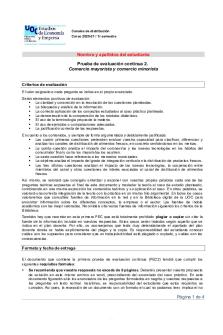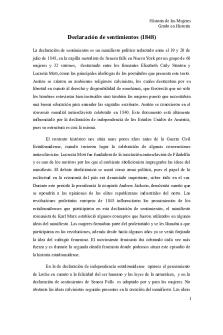PEC2. Declaration Seneca Falls. MMAA PDF

| Title | PEC2. Declaration Seneca Falls. MMAA |
|---|---|
| Author | M Jose Perez |
| Course | Mundos Anglófonos |
| Institution | UNED |
| Pages | 6 |
| File Size | 169.1 KB |
| File Type | |
| Total Downloads | 69 |
| Total Views | 163 |
Summary
PEC2 MMAA...
Description
SENECA FALLS DECLARATION OF SENTIMENTS AND RESOLUTIONS 1848
Nombre: Mª Josefa Pérez Gómez DNI: 14304607X Centro Asociado de Cádiz.
“The declaration of sentiments”, also known as “the Declaration of Rights and Sentiments”, is an historical document signed in 1848 by 68 women and 32 men, 100 out of some 300 attendees at the first women's rights convention in the United States (now known as Seneca Fall Convention) to be organized by women. The Declaration of sentiments and resolutions was drafted and read by Elisabeth Cady Stanton, who organized the convention along with Lucrecia Mott. It was held at the Wesleyan Chapel in Seneca Falls, New York, on July 19 and 20, 1848. The Wesleyan Methodic Chapel was a well-known place since it was a local haven for antislavery activity, political rallies, and free speech events at that time. The declaration was addressed not only to the attendees at the convention but also the whole nation. Cady Stanton was, with her husband and her cousin, a convinced abolitionist activist; and Mott came from a Quaker family that believed in equality, at the point that her house in Philadelphia operated as a station of the “Underground Railroad” that provides African Americans a way to escape from slavery. The two feminist leaders had been excluded from participating in the 1840 World Anti-Slavery Convention in London, an event that solidified their determination to engage in the struggle. Elisabeth Cady Stanton made clear that the purpose of the meeting was to discuss the “social, civil, and religious condition and rights of woman”, so the Declaration of sentiments and resolutions was a statement of grievances and resolutions demanding that women should have equality in family, education, jobs, religion and morals and it was also the first pronouncement demanding that women be given the right to vote. The Declaration of sentiments took the Declaration of Independence from 1776 as a model, Stanton changed a few words of the Declaration of Independence to make it appropriate for a statement by women, replacing "The history of the present King of Great Britain" with "The history of mankind" as the basis for "usurpations on the part of man toward woman", she added the phrase "and women" to make "... all men and women are created equal ..." 1848 was an important year in many aspects, and decisive for the feminist movement. While Marx and Engels published their Communist Manifesto, liberal ideas about participation in society were raising and women and African Americans
wanted to be part of this social change. The resurgence of a social, religious and cultural debate allowed a reinforcement of the American civil society and the birth of reformist movements like abolitionism, feminism, and others with a similar target: the regeneration of American moral values.
In the decade of 1840’s, primary conditions for the awakening of a new consciousness as a gender by American women were given. Due to the peculiarity of the development of the nation, in expansion towards the West, the active participation of women in areas as education or evangelization was raising, but only in those limited fields. The New York Female Moral Reform Society was focused in fighting prostitution since 1834. In 1839, Mississippi passes the first Married Woman’s Property Act. In 1844, female textile workers organize in Massachusetts the Lowell Female Labor Reform Association and demand a 10-hour workday; and the abolitionist movement had the support of many women threw into. Two of those women were Elizabeth Cady Stanton and Lucretia Mott. This activism was the spirit of the Seneca Falls Convention.
The document begins with a prologue, in which first paragraph justifies the document as a logical response to God’s and nature’s commands “the laws of nature and of nature’s God entitle them”. Based on religious references and American society ideology the text follows with the sentence in the second paragraph “they (men and women) are endowed by the Creator with certain inalienable rights; that among these are life, liberty, and the pursuit of happiness” meaning that everyone should be protected by the same laws for sacred reasons; and follows claiming with the same words that were in the Declaration of Independence, but adding and women to the sentence “all men and women are created equal”. The text even dares to refuse allegiance to the government as the fathers of the nation had done before when says “Whenever any form of government becomes destructive of these ends, it is the right of those who suffer from it to refuse allegiance to it”, in this case, women cannot agree with the government.
In the same Declaration-of-Independence-revolutionary-form, the first part, the sentiments, contains the motivations of the feminist movement headed by the dramatic statement: “The history of mankind is a history of repeated injuries and
usurpations on the part of man toward woman, having in direct object the establishment of an absolute tyranny over her”. The list of injures and affronts exposed the abusive situation that women had been suffering because of what man has done and how the maintenance of patriarchy is structured; and made an urgent claim for an immediate recognition of women’s rights and privileges as citizens of the U.S. “ …because women do feel themselves aggrieved, oppressed, and fraudulently deprived of their most sacred rights, we insist that they have immediate admission to all rights and privileges which belong to them as citizens of the United States”
The second part, a set of twelve resolutions, defined the goals for this first American feminist movement, such as property and divorce rights, educational and employment opportunities and the right to vote. The Convention passed unanimously all the resolutions except the ninth one, “It is the duty of the women of this country to secure to themselves their sacred right to the elective franchise”, which demanded the woman’s right to vote. This resolution was drafted by Stanton herself and passed only just the insistence of her. Stanton added the issue of woman suffrage on more than one occasion: To the grievances, she added "He has never permitted her to exercise her inalienable right to the elective franchise", and to the Sentiments, she added a line about man depriving woman of "…the elective franchise, thereby leaving her without representation in the halls of legislation ..." The issue of women’s voting right has a relevant consideration from a historical point of view because it served as the cornerstone of the woman suffrage movement that culminated in passage of the Nineteenth Amendment in 1920. Although at that moment it subjected the Seneca Falls Convention to subsequent ridicule and caused many backers of women’s rights to withdraw their support, even Stanton’s husband, when he saw the addition of woman suffrage, warned his wife "you will turn the proceedings into a farce." He, like most men of his day, was not in favor of women gaining voting rights. Because he intended to run for elective office, he left Seneca Falls to avoid being connected with a convention promoting such an unpopular cause. For this reason the women’s movement was divided into two groups. Despite the facts that only one hundred out to three hundred attendants signed the document and that a few contemptuous and mocking articles were published among
other positive reactions in the papers, the general feeling was of success, and similar conventions took place in Rochester, Ohio, and Pennsylvania. The way was open and two years later when the National Women’s Rights Convention was arranged in Worcester, Massachusetts, women suffrage had become a fundamental issue.
The Declaration of Sentiments can be considered the foundational text of feminist movement in American History. From the attendants at the Seneca Falls meetings, just one, Charlotte Woodward, lived enough to see in 1920 the first presidential election where women could vote.
Women like Cady Stanton and her companions were brave enough to face a society that ignored them and show all the women that action was needed then and, as long as the goals of feminism aren’t achieved yet, is needed now.
I think it is remarkable that this text was not a request but a direct demand. They weren’t asking for permission to vote, but demanding a right as natural as breath and supporting this demand as a God’s mandate.
The fact that the document was written with the tone and words taken from the Declaration of Independence was a witty move by Elizabeth Cady Stanton. In this way any argument could be used by men to reject the same logical speech that had legitimated them before. In addition, this inspiration would give the text a wider spreading. Knowing these facts I can only feel admiration for Elizabeth C. Stanton, her perseverance and her bravery for raising her voice on behalf of all women to the present.
BIBLIOGRAPHY:
American Civilization: An introduction, David and john Oakland. https://en.wikipedia.org/wiki/Declaration_of_Sentiments https://www.co.seneca.ny.us/wp-content/uploads/2014/11/Birth-of-the-Womens-RightsMovement-in-Seneca-County-1-ADA.pdf https://constitutioncenter.org/blog/on-this-day-the-seneca-falls-convention-begins...
Similar Free PDFs

Seneca falls
- 2 Pages

78587 20201 PEC2 - PEC2
- 4 Pages

Seneca- analisi
- 10 Pages

Seneca fedra
- 6 Pages

PEC2 Soluciones
- 6 Pages

The Niagara Falls
- 1 Pages

Preventing-Employee-Falls
- 11 Pages

De ira -Seneca
- 51 Pages

Chapter 11 falls notes
- 7 Pages

seneca vita e opere
- 4 Pages

LRS Declaration
- 1 Pages

Parent declaration
- 1 Pages
Popular Institutions
- Tinajero National High School - Annex
- Politeknik Caltex Riau
- Yokohama City University
- SGT University
- University of Al-Qadisiyah
- Divine Word College of Vigan
- Techniek College Rotterdam
- Universidade de Santiago
- Universiti Teknologi MARA Cawangan Johor Kampus Pasir Gudang
- Poltekkes Kemenkes Yogyakarta
- Baguio City National High School
- Colegio san marcos
- preparatoria uno
- Centro de Bachillerato Tecnológico Industrial y de Servicios No. 107
- Dalian Maritime University
- Quang Trung Secondary School
- Colegio Tecnológico en Informática
- Corporación Regional de Educación Superior
- Grupo CEDVA
- Dar Al Uloom University
- Centro de Estudios Preuniversitarios de la Universidad Nacional de Ingeniería
- 上智大学
- Aakash International School, Nuna Majara
- San Felipe Neri Catholic School
- Kang Chiao International School - New Taipei City
- Misamis Occidental National High School
- Institución Educativa Escuela Normal Juan Ladrilleros
- Kolehiyo ng Pantukan
- Batanes State College
- Instituto Continental
- Sekolah Menengah Kejuruan Kesehatan Kaltara (Tarakan)
- Colegio de La Inmaculada Concepcion - Cebu



